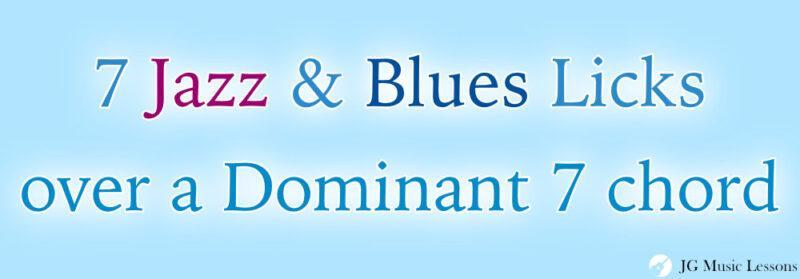This lesson covers 7 jazz and blues licks to get better at improvising over dominant 7th chords. The purpose of learning these licks (musical phrases) is to expand your vocabulary, break down the information, and use them as a guide to create your own lines.
All the examples will be over a G 7 chord but they would also work over a G 9 chord.
If needed, check out how to play Dominant arpeggios on guitar if you don’t know how to already.
Although these licks are written with guitar tabs, they can be applied to other instruments as well. Grab your guitar and let’s get started!
Lick 1
For the first lick, we are mostly thinking of the scale notes for a G mixolydian scale, which has the notes G, A, B, C, D, E, and F. The only exception is the approach note which is a half step below the 3rd of the chord.

Lick 2
For lick 2, we are highlighting two 6th intervals (B to G and A to F). We approach and connect them using chromatic notes (consecutive half steps). This pattern creates a classic blues style lick.

Lick 3
Lick 3 incorporates a triplet on beat two and also uses chromatic notes. This phrase highlights many chord tones on the strong beats. For example, the 3rd on beat 2, the 7th on beat 3 and the 5th on beat 1 of measure 2.

Lick 4
Lick 4 imposes a G minor blues scale over the dominant 7 chord. This is essentially a minor pentatonic scale with an added blues note, which in this case is C#.

Lick 5
This jazz lick uses the dominant bebop scale which adds a half step between the b7 and root note.

Lick 6
For lick 6, we use 7th arpeggios within the diatonic notes. For example, we have an F Major 7 chord arpeggio on the first five notes of the phrase and a B minor 7 b5 arpeggio on the first four notes of measure 2.

Lick 7
This jazz lick uses upper extension chord tones within the scale. For example, the first 6 notes spell out a D minor 7 chord with the 9th (E) and 11th (G). We finished the phrase in descending scale motion while mixing in some chromatic approach notes.

Wrapping up
Learning these 7 jazz and blues style licks over a dominant chord will help you expand your music vocabulary. They can help you understand how musical phrases are created by using chord tones, scale notes, arpeggios, chromatic, approach notes, etc…
Since we only focused on playing over one dominant chord, I recommend trying to transpose these melodies over different dominant chords. This will not only help you retain the sound of each phrase in your ears but also challenge you to find different ways of playing the notes on your instrument.
To practice applying these licks, check out the chord progressions covered in how to play a 12 bar blues on guitar or how to play a minor blues progression.
If you liked this material, you might also be interested in these 9 ways to make your melody lines sound jazzy or how to play Barry Harris’ Major 6th diminished scale on guitar.
📘 Get the free guitar practice guide here!
Best,
JG Music Lessons
📙 Kickstart your guitar playing with our step by step guide: Guitar Essentials.
🎸 Looking for a travel or half-sized guitar? See this one.
🛠 See our other music recommendations.
🤝 Support the site to help us to create better content for you!
Level up with the FREE guitar practice guide and effectively improve your playing! 🎸
Get it sent to your email!



